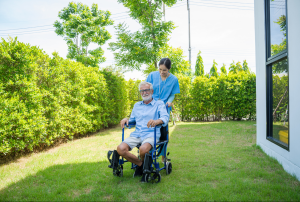Understanding the National Disability Insurance Scheme and Home Modifications
Home modifications under the National Disability Insurance Scheme (NDIS) encompass a range of alterations and adaptations made to a participant’s home environment to improve accessibility, sa2fety, and independence.
These modifications are tailored to meet the specific needs of individuals with disabilities, ensuring they can navigate their living spaces with ease and dignity. The primary goal of NDIS-funded home modifications is to create an environment that supports individuals in carrying out daily activities, promoting autonomy and quality of life.
Complex vs Minor home modifications
Minor home modifications typically involve relatively simple changes that do not alter the structural integrity of the home and are cost-effective, typically costing less than $20,000. Examples include installing grab rails, handrails, lever door handles, or ramps to improve accessibility and safety. These modifications are designed to address specific barriers encountered by individuals with disabilities in their daily activities and promote greater ease of movement and independence within the home.
On the other hand, complex home modifications are more extensive and may require significant alterations to the home’s structure or layout. These modifications are tailored to meet the unique needs of individuals with more complex disabilities and may involve combining rooms, widening doorways, installing specialized equipment, or making structural changes to accommodate mobility aids.
Complex modifications often require detailed assessments by qualified professionals, such as occupational therapists or building assessors, to ensure they effectively meet the participant’s needs and goals. Making modifications align with your goals is an important part of the process.
The key differences between minor and complex home modifications lie in their scope, complexity, and cost. Minor modifications focus on addressing specific accessibility barriers and can usually be completed relatively quickly and affordably. In contrast, complex modifications may involve significant planning, coordination, and investment to implement, as they often require structural changes and specialized equipment to meet the participant’s complex needs comprehensively. Think of Nursedcare’s website as your home modification information clearinghouse. We are here to support you torwards living your best life possible.
Common Examples of Home Modifications
Bathroom Modifications
These include adding grab rails for support, adjustable-height showerheads for convenience, and non-slip flooring to prevent accidents. These changes ensure that individuals can safely manage personal care tasks like bathing and toileting without assistance.
Kitchen Modifications
Adjusting countertop heights, organizing storage to make items easily reachable, or installing assistive technology like lever-operated faucets are all home modifications that can be made. These adjustments enable individuals to prepare meals independently, fostering independence in the kitchen.
Ramp Construction
Installing ramps at entrances removes obstacles for wheelchair users and those with mobility issues, facilitating seamless access to and from the home. This modification promotes freedom of movement and inclusivity and not only allows for a safer living environment but also allows for people to feel ownership over their living space.
Doorway Widening
Enlarging doorways allows for easier passage of wheelchairs, walkers, and other mobility aids between rooms. It enhances accessibility throughout a person’s home environment making navigation more manageable for individuals with mobility challenges.
Handrail Installation
Adding handrails along corridors and staircases provides stability and support, reducing the risk of falls for those with balance issues or limited mobility. These modifications contribute to added security, especially in areas prone to slips and trips.
Flooring and Lighting Modifications
Installing non-slip flooring surfaces and improving lighting enhance safety and visibility within the home. These changes minimize the risk of accidents, particularly for individuals with visual impairments or mobility limitations.
Overall, NDIS home modifications aim to remove physical barriers, improve accessibility, and foster independence for individuals with disabilities. By addressing specific needs within the bathroom, kitchen, entryways, and other areas of the home, these modifications empower individuals to live comfortably and confidently, promoting their overall well-being and quality of life.
Sarah's Home Modifications: Creating an Accessible Bathroom
Sarah, a spirited individual living with cerebral palsy, faced daily challenges navigating her home, particularly the bathroom. Stepping into the shower and reaching for faucets proved arduous tasks, impeding her independence. Determined to enhance her quality of life, Sarah embarked on a transformative journey with the National Disability Insurance Scheme (NDIS) to modify her bathroom.
Identifying the Need for Change
Sarah’s occupational therapist conducted a comprehensive assessment funded by her NDIS plan, pinpointing the bathroom as a critical area requiring modification. Sarah expressed her struggles with shower accessibility and faucet operation, highlighting the urgent need for change to improve her daily routine and promote independence.
Planning the Bathroom Transformation
Collaborating with one of the many brilliant occupational therapists that the NDIS uses, Sarah devised a tailored plan to transform her bathroom into an accessible space. The plan included installing a roll-in shower with grab bars for stability and replacing traditional faucets with long-handled, lever-operated ones for ease of use. Sarah ensured the proposed modifications aligned with her long-term goals of increased autonomy and enhanced quality of life.
Securing Funding and Approvals
Sarah navigated the process of securing NDIS funding for the bathroom modifications diligently. She obtained written approvals from her landlord and relevant authorities, ensuring compliance with regulatory requirements. Sarah provided detailed documentation outlining the proposed modifications’ necessity and alignment with NDIS guidelines, expediting the funding approval process.
Transformation in Action
With funding secured, Sarah’s bathroom transformation commenced. Skilled contractors executed the planned modifications under her therapist’s supervision, ensuring precision and adherence to accessibility standards. The bathroom underwent a remarkable metamorphosis as the roll-in shower and lever-operated faucets were installed, enhancing accessibility and functionality.
Life After the Bathroom Modification
As Sarah’s accessible bathroom took shape, her daily routine underwent a profound transformation. She could now enter the shower safely and operate the faucets effortlessly, reclaiming a sense of independence and dignity. With her bathroom tailored to her needs, Sarah’s confidence soared, empowering her to tackle daily challenges with renewed vigour and autonomy.
In conclusion, Sarah’s journey exemplifies the transformative impact of a single NDIS-funded home modification. Through careful planning and collaboration, Sarah overcame the barriers within her bathroom, unlocking her newfound freedom. The new bathroom allowed for fostering independence that would not have been possible without these changes.
Her story serves as a reminder that those who face mobility challenges or struggle to perform daily tasks independently need not fret. Minor home modifications that you can make under the NDIS home modifications scheme can be the difference to unlocking a whole new quality of life that we all deserve.
Case Study: Enhancing Accessibility with Ramp Installation
Ron, a participant in the NDIS program, faces mobility challenges due to a spinal cord injury, relying on a wheelchair for movement. Residing in a two-story house with steps leading to the front entrance, Ron’s independence is hindered by the lack of accessible entry points. Seeking to improve his quality of life, Ron prioritizes the installation of a ramp to enhance accessibility to his home.
Assessment and Recommendation
Ron’s occupational therapist conducts a thorough assessment of his home environment and identifies the need for a ramp to facilitate easy access. The therapist recommends installing a ramp at the front entrance to eliminate barriers and enable Ron to navigate in and out of his home safely and independently. The ramp design includes appropriate slope gradients and non-slip surfaces to ensure Ron’s safety and comfort.
Approval and Installation
Ron, in collaboration with his occupational therapy services, compiles a comprehensive assessment report underscoring the necessity of a ramp for his mobility and well-being. He obtains written consent from his landlord and submits the requisite documentation to his NDIS planner, resulting in the approval of funding for the ramp installation.
With the financial support secured, Ron enlists the expertise of a licensed builder skilled in constructing ramps for individuals with disabilities. Together with his occupational therapist, they ensure the ramp design meets Ron’s specific needs and adheres to safety standards. Construction promptly commences, culminating in the installation of a custom-built ramp at Ron’s home, providing him with enhanced accessibility and independence.
Outcome and Impact
The completion of the ramp installation marks a transformative milestone in Ron’s life. No longer confined by steps, Ron gains newfound freedom and autonomy to navigate in and out of his home effortlessly. By removing physical barriers that once impeded his mobility, empowering Ron to engage more actively in daily activities and interact with his community.
The impact of the ramp extends beyond physical accessibility, significantly enhancing Ron’s overall well-being and mental health. With increased independence, Ron experiences a renewed sense of confidence and self-reliance, fostering a positive outlook on life. He no longer feels limited by his disability but instead embraces newfound opportunities to explore and participate fully in the world around him.
Moreover, It gave him the holistic support that Ron needed to take ownership of his living space. With the assistive technology contributing to the inclusivity that the Ramp allowed for, Ron was able to have friends, family, and visitors of all abilities access the property with ease. It fosters a supportive and inclusive environment where everyone feels welcome and valued, strengthening social connections and relationships.
In essence, the installation of the ramp represents more than just a physical modification—it symbolizes freedom, empowerment, and inclusion for Ron. By overcoming accessibility barriers, Ron’s quality of life is significantly enhanced, enabling him to lead a more fulfilling and independent lifestyle as an active participant in his community.
Case Study: Improving Accessibility with Lighting Modifications
Scenario: Emma, a participant in the NDIS program, experiences visual impairment due to a degenerative eye condition. Living in a dimly lit apartment, Emma struggles with navigating her home safely and independently, leading to increased feelings of frustration and isolation. Recognizing the importance of adequate lighting for her well-being, Emma seeks to enhance the lighting in her living space through NDIS-funded modifications.
Outcome and Impact:
Upon assessment by her occupational therapist, Emma’s primary need is identified as improved lighting to mitigate the challenges posed by her visual impairment. With funding approved under her NDIS plan, Emma collaborates with a qualified electrician to implement lighting modifications tailored to her specific needs.
The completion of the lighting modifications marks a significant transformation in Emma’s daily life. Enhanced lighting fixtures installed strategically throughout her apartment illuminate key areas, including hallways, entrances, and living spaces. The increased brightness and visibility provide Emma with a newfound sense of confidence and security, enabling her to navigate her home with greater ease and independence.
The impact of the lighting modifications extends beyond physical accessibility, positively influencing Emma’s mental well-being and overall quality of life. With improved lighting, Emma experiences reduced anxiety and stress associated with navigating her home, fostering a greater sense of comfort and relaxation in her living environment. Moreover, the enhanced visibility enhances Emma’s ability to engage in daily activities, such as reading, cooking, and socializing, promoting a greater sense of autonomy and participation in her home life.
In essence, the implementation of lighting modifications represents more than just a practical improvement—it signifies a profound enhancement in Emma’s quality of life and well-being. By addressing the specific challenges posed by her visual impairment, Emma gains greater independence, confidence, and comfort in her living space, empowering her to thrive and engage fully in her daily activities and interactions.
Call Us
Nursed Care Sydney is an accredited NDIS Care provider based in Parramatta, proudly serving the broader Sydney region. We find out what your needs are and available funding options to meet these. We then assess your property and liaise with your Occupational Therapist to obtain NDIS funding. Over the years we have helped many in our community with the transformative home modifications that they have needed to live the best lives possible. Get in touch with Nursed today and let us assist you in paving a path that ensures you receive all the support you deserve.






